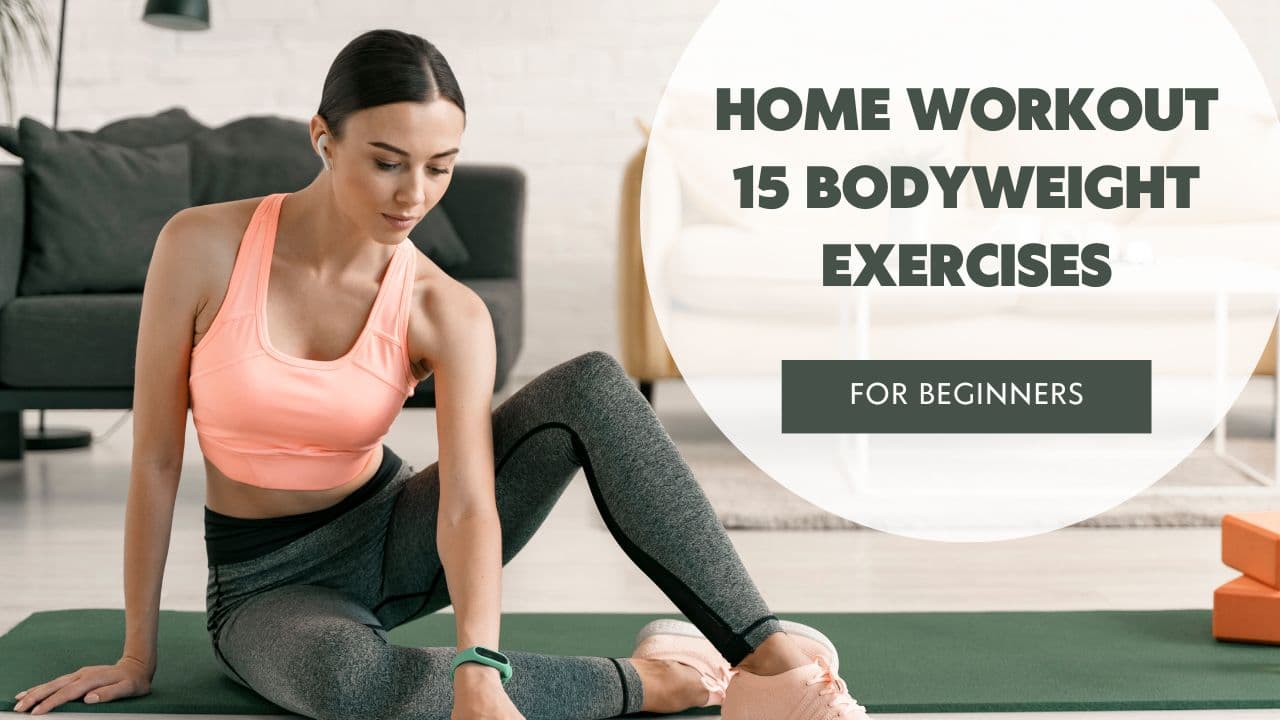Why Bodyweight Training Travels Anywhere
At some point, everyone has that week where the gym key fob just sits in your bag and quietly judges you. Travel, late meetings, kids, dark winter evenings that feel like 10 pm at 4:30. Life stacks up.
Bodyweight training is the backup plan that doesn’t feel like a backup plan. It keeps your joints moving, your strength honest, and your conditioning sharp without needing a single dumbbell. No rack, no cable stack, no problem.
The 15 exercises below are all pulled directly from the LoadMuscle database, the same one our AI workout planner uses when it designs real training plans for real people. So every target muscle, every “beginner” or “intermediate” tag, every category label is based on the same structured data hiding behind the scenes in the app.
How to Use This Guide
Before you start trying to PR your burpees in the living room, give your body a small runway.
- Warm up with about 5 minutes of light movement: joint circles, a few rounds of cat-cows, some easy bodyweight squats to open your hips and upper back.
- For each session, pick 4–6 movements:
- 2 lower-body exercises
- 2 pushing or pulling upper-body moves
- 1–2 core or conditioning finishers
- For conditioning-focused work, use simple “density” blocks like 40 seconds on / 20 seconds off.
- For strength-focused work, stick with 3×8–15 reps and controlled tempo.
- Each week, try to progress before you jump to a tougher variation:
- Slow the negative for 3 seconds
- Add brief isometric holds
- Trim a bit of rest time
Think of this less as a strict “plan” and more as a deck of cards you can reshuffle depending on your energy, your schedule, and whether your downstairs neighbor is home.
15 Anywhere Exercises from the LoadMuscle Dataset
| # | Exercise | Primary Target | Best For |
|---|---|---|---|
| 1 | Prisoner Squat | Quadriceps | Lower-body strength + posture |
| 2 | Bodyweight Rear Lunge | Gluteus Maximus | Single-leg stability |
| 3 | Glute Bridge Two Legs on Floor | Gluteus Maximus | Posterior-chain activation |
| 4 | Inverted Row | Back | Horizontal pulling power |
| 5 | Push-up | Pectoralis Major | Total upper-body pressing |
| 6 | Pike Push-up (on Bench) | Pectoralis Major | Shoulder-dominant pressing |
| 7 | Superman | Erector Spinae | Low-back endurance |
| 8 | Front Plank | Rectus Abdominis | Anti-extension core control |
| 9 | Side Plank | Obliques | Lateral core stability |
| 10 | Dead Bug | Rectus Abdominis | Core + breathing coordination |
| 11 | Hollow Hold | Rectus Abdominis | Gymnastics-level trunk tension |
| 12 | Mountain Climber | Hip Flexors | Core-friendly cardio |
| 13 | Bear Crawl | Shoulders | Total-body locomotion |
| 14 | Jumping Jack | Cardiovascular System | Low-impact conditioning |
| 15 | Burpee | Cardiovascular system | Full-body HIIT finisher |
Exercise Breakdowns and Programming Notes
1. Prisoner Squat
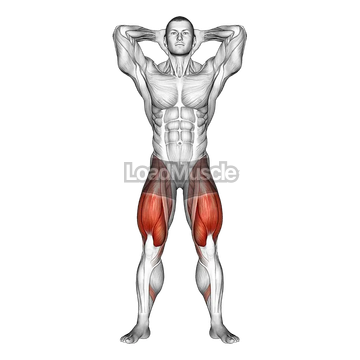
Classified as a thighs-focused strength exercise with the quadriceps as the main target muscle and a beginner-friendly difficulty rating.
Why it works: Putting your hands behind your head forces you to stay tall through the torso, which quietly improves ankle mobility, hip control, and bracing habits instead of letting you fold into a “desk posture” squat.
Coaching cues
- “Screw” your feet gently into the floor and pull your ribs down before you move.
- Keep the elbows wide so your chest doesn’t cave.
- Sit down until your thighs hit about parallel, then push the floor away on the way up.
Progression path: Slow the descent to a 3-second count or add 5 small “pulse” reps at the bottom of each set before standing tall again.
2. Bodyweight Rear Lunge
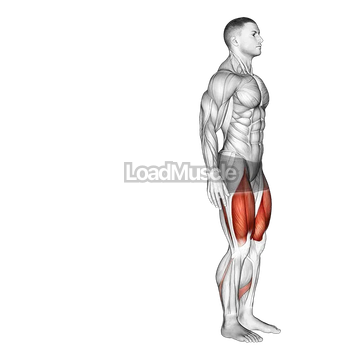
A thighs-pattern movement that primarily hits the gluteus maximus and is tagged as an intermediate strength exercise.
Why it works: Stepping backward loads the front leg without smashing your front knee, which makes it ideal in tight spaces and on less-than-perfect flooring.
Coaching cues
- Step back as if you’re on a narrow “rail” so your feet stay about hip-width, not tightrope-wide.
- Drop your hips straight down, keeping the front shin roughly vertical.
- Push through the middle of your front foot to stand up instead of pitching your chest forward.
Progression path: Elevate the front foot a few inches or add a controlled knee drive at the top to challenge balance and hip stability.
3. Glute Bridge Two Legs on Floor

Categorized as a hips exercise that targets the gluteus maximus and sits in the beginner strength bucket.
Why it works: Bridges “wake up” sleepy glutes from too much chair time and prepare your body for deeper squats, hinges, and even running.
Coaching cues
- Lie on your back with knees bent, heels roughly under your knees, toes pointing forward.
- Brace gently, drive your heels into the floor, and squeeze your glutes firmly at the top.
- Lower your hips with control, one vertebra at a time, instead of just dropping.
Progression path: Shift to a single-leg bridge or hold a 3-second squeeze at the top of every rep.
4. Inverted Row
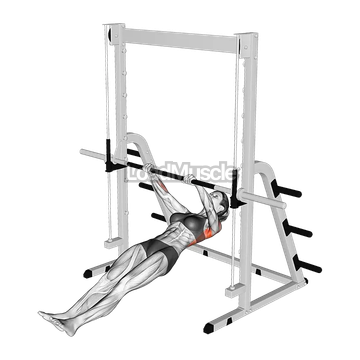
Filed under “back” with the general back region as the target and an intermediate strength rating.
Why it works: Horizontal pulling balances all the push-ups and presses you do, builds scapular control, and can be done with rings, a sturdy table edge, or suspension straps.
Coaching cues
- Use a neutral or comfortable grip and hold your body in a straight “plank” from head to heels.
- Pull your elbows toward your ribcage or hips, squeezing your shoulder blades toward each other.
- Lower slowly until your arms are straight without shrugging your shoulders toward your ears.
Progression path: Raise your feet on a bench or slow the tempo to about 2 seconds up and 2 seconds down.
5. Push-up
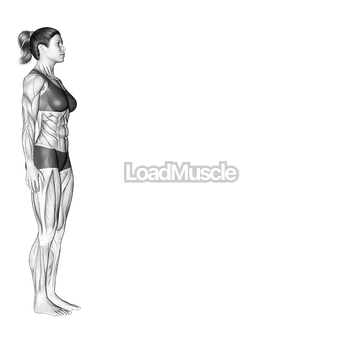
Tagged as a movement involving the chest, hips, and waist, with the pectoralis major as the primary target and an intermediate skill level.
Why it works: It’s still the classic bodyweight press that trains your chest, shoulders, triceps, and core all in one neat, slightly humbling package.
Coaching cues
- Place your hands under your shoulders with a small outward rotation so the elbows don’t flare hard.
- Keep a straight line from ears to ankles, avoiding sagging hips or a pike position.
- Lower until your elbows are around 45 degrees from the body, then exhale as you press back up.
Progression path: Elevate your hands on a bench or counter to make it easier or use push-up handles/deficit to increase range when you’re stronger.
6. Pike Push-up
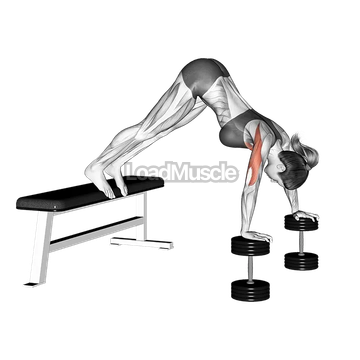
Stored as a chest exercise with the pectoralis major as the target muscle and an intermediate difficulty rating.
Why it works: By shifting your hips up and your torso more vertical, you send a lot more of the load into your shoulders and upper chest, almost like a bodyweight overhead press.
Coaching cues
- Place your feet or hands on a bench, hinge at the hips, and form a tight inverted “L” shape.
- Aim the crown of your head gently toward the floor so it feels like you’re pressing more “up” than “forward.”
- Keep your core braced and avoid arching your lower back as fatigue creeps in.
Progression path: Walk your feet closer to your hands to steepen the angle or start building toward wall-supported handstand push-ups over time.
7. Superman
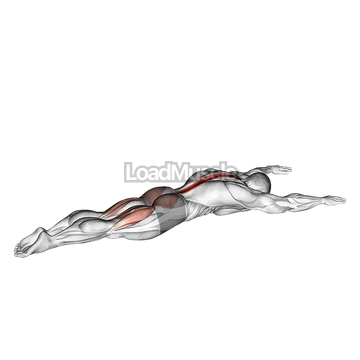
A hips-category movement focused on the erector spinae with a beginner difficulty tag.
Why it works: It trains low-back endurance and glute co-contraction, which helps offset all the slouched sitting and phone-scrolling posture most of us rack up every day.
Coaching cues
- Lie face down with your arms reaching overhead and thumbs pointing up.
- Brace gently, then lift your arms and legs a few inches without crunching your neck or yanking your head up.
- Hold for 2–3 seconds at the top and then lower with control.
Progression path: Alternate lifting opposite arm and leg or add tiny pulses at the top to extend the time under tension.
8. Front Plank
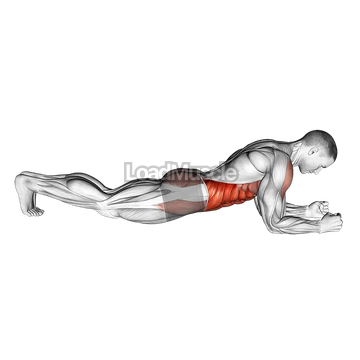
Categorized as a waist movement that primarily targets the rectus abdominis at a beginner level.
Why it works: A good plank teaches full-body tension from shoulders to toes, which carries over into everything from squats and presses to running and even carrying groceries.
Coaching cues
- Set elbows directly under your shoulders, forearms parallel, and gently press your fists together.
- Squeeze glutes and quads while pulling your ribs toward your hips.
- Breathe steadily through your nose and avoid letting your hips sag or drift too high.
Progression path: Try high-tension “RKC” planks for 10–20 seconds or add slow shoulder taps without letting the hips rock side to side.
9. Side Plank
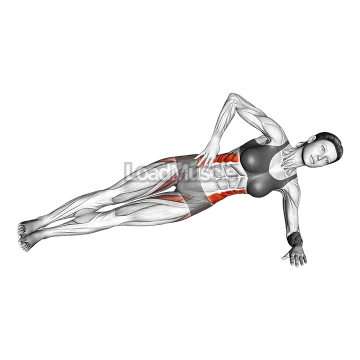
Tagged as a waist exercise targeting the obliques at an intermediate skill level.
Why it works: Side planks build anti-lateral-flexion strength, which protects your spine when you carry things, press overhead, or run on uneven ground.
Coaching cues
- Stack your elbow under your shoulder, with feet either stacked or staggered.
- Drive your hips up so your body forms a straight line from ankles to ears.
- Keep your top shoulder open, chest facing forward, and neck long.
Progression path: Add top-leg lifts for extra challenge or hold a light weight overhead to increase rotational demand.
10. Dead Bug
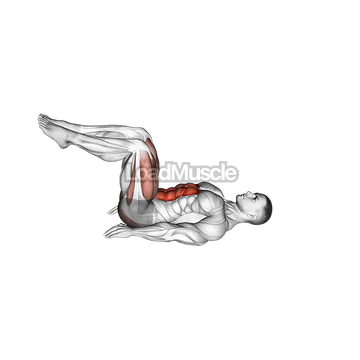
Labeled as a waist-focused move targeting the rectus abdominis with a beginner difficulty rating.
Why it works: It ties together breathing, pelvic control, and diagonal limb coordination, which shows up whenever you squat, hinge, or carry loads.
Coaching cues
- Start on your back with knees over hips and hands stacked above your shoulders.
- Press your lower back into the floor and inhale through your nose.
- Slowly extend the opposite arm and leg while keeping your ribs pinned down, then return to the start with control.
Progression path: Squeeze a light medicine ball between hands and knees or loop a resistance band around your feet for added tension.
11. Hollow Hold

Stored as a waist exercise with the rectus abdominis as the primary target and an intermediate skill rating.
Why it works: This is a staple gymnastic core position that builds serious trunk stiffness for things like pull-ups, handstands, and explosive lifts.
Coaching cues
- Flatten your lower back into the floor, then lift your shoulders and legs a few inches.
- Reach long through your fingertips and toes, keeping your body in a “hollow” curved shape.
- Breathe slowly; if your low back starts to pop off the floor, bend your knees to shorten the lever.
Progression path: Add gentle hollow rocks, hold a light plate overhead, or build sets to 30 seconds and beyond as you adapt.
12. Mountain Climber
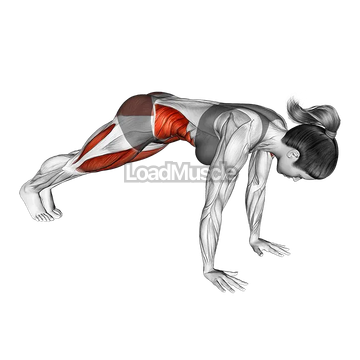
Categorized as a cardio movement that targets the hip flexors with an intermediate skill label.
Why it works: It doubles as a core drill and a cardio interval, spiking your heart rate without requiring jumping or heavy impact.
Coaching cues
- Start in a strong push-up plank with hands under shoulders.
- Drive one knee toward your chest while the other leg stays long.
- Switch legs rhythmically and keep your hips level and ribs tucked.
Progression path: Use sliders under your feet, slow the tempo for more core burn, or sprint intervals like 20 seconds on and 10 seconds off.
13. Bear Crawl
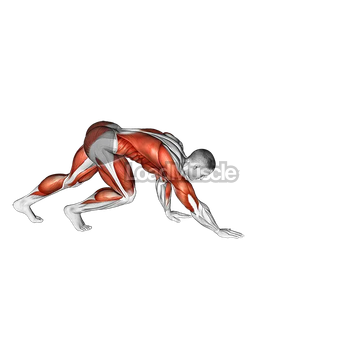
Placed in the cardio category, primarily targeting the shoulders at an intermediate skill level.
Why it works: It’s loaded locomotion for real life, tying together shoulder stability, core control, and coordination in a way that feels oddly playful and oddly humbling.
Coaching cues
- Set up on hands and knees, then hover your knees an inch off the ground under your hips.
- Move opposite hand and foot together in short, controlled steps.
- Keep your spine flat and your gaze a little in front of your hands.
Progression path: Crawl backward, move side to side, or attach a light band around your hips for extra resistance.
14. Jumping Jack
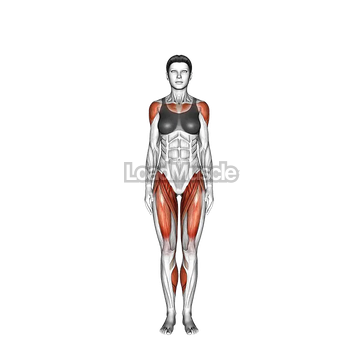
A cardio-focused exercise targeting the cardiovascular system with a beginner difficulty tag.
Why it works: It quickly elevates your heart rate without demanding advanced coordination, which makes it perfect as a warm-up or steady, easy movement between heavier sets.
Coaching cues
- Land softly on the balls of your feet with knees slightly bent.
- Keep your arms relaxed but bring them fully overhead for a complete range of motion.
- Match your breathing rhythm: inhale on the way down, exhale on the way up if that pattern feels natural.
Progression path: Switch to “power” jacks with a deeper squat and overhead reach or use short Tabata-style rounds for quick conditioning.
15. Burpee
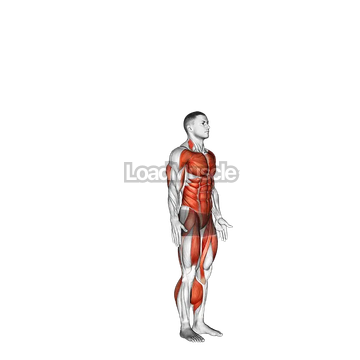
Listed as an aerobic exercise with the cardiovascular system as the primary target and an intermediate skill classification.
Why it works: It strings together a squat, plank, and jump into one full-body HIIT closer that chews through calories and tests your pacing, not just your willpower.
Coaching cues
- Place your hands under your shoulders and jump or step your feet back into a straight plank.
- Keep your core braced as you lower to the floor, then snap your feet back under you.
- Finish with a tall, relaxed jump and soft landing before repeating.
Progression path: Add a push-up at the bottom or a tuck jump at the top, or run EMOMs (every minute on the minute) to challenge your pacing and recovery.
Plug-and-Play Home Workout Templates
You don’t need to reinvent the wheel each time you train at home. Use these templates exactly as written or as loose blueprints when your brain is fried from work and decisions.
| Goal | Structure | Work Sets | Notes |
|---|---|---|---|
| Strength Base | Pair #1 + #2, #4 + #5, finish with #8 | 3–4×8–12 reps | Rest 60–90 seconds between sets and lean into controlled tempo on each rep |
| Athletic Conditioning | Circuit #3 → #6 → #12 → #13 → #14 | 40s on / 20s off × 3 rounds | Aim for about 7/10 effort and keep breathing mostly through your nose if you can |
| Core Emphasis | Trio #8 → #9 → #11 → #10 | 3 rounds | Keep rest short, stay focused on quality tension more than chasing fatigue |
| HIIT Finisher | #12 → #15 ladder | 20s work / 10s rest for 8 minutes | Alternate between the two moves each interval so the challenge shifts but doesn’t fully let you off the hook |
You can also plug any of these into an existing gym routine. For example, keep your lower-body day the same and run the “Core Emphasis” block afterward at home on days when you’re short on time. Not perfect, but honestly, pretty effective.
Keep Progressing with LoadMuscle
If you reach the point where you’re bored of picking movements manually or you just want someone (or something) to think for you, that’s when LoadMuscle really shines.
The LoadMuscle AI Workout Planner uses this same underlying exercise database, along with your goals, schedule, and available space, to automatically rearrange and progress these movements in a sensible way. Think of it like having a coach who never forgets what you did last week.
👉 When you’re ready to spin these exercises into a custom session in a few seconds, try the Online Fitness Planner and let it handle the planning while you handle the training.
